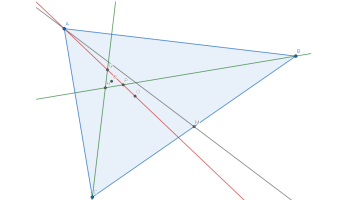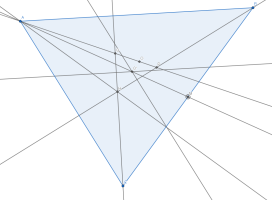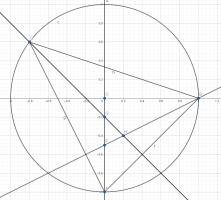Hi everyone, I've been working on this geometry problem today and feel like I'm close to cracking it — but I could use some help with one final step. I'm trying to show that:
[math]\Im(\overline{A}M) \left[ \Im(H\overline{P}) - \Im(H\overline{Q}) + \Im(P\overline{Q}) \right] = \left( |H|^2 - |P|^2 \right) \Re\left( \overline{M - A} \cdot v \right) - \left( |P|^2 - |Q|^2 \right) \Re\left( \overline{u} \cdot (M - A) \right)[/math]
Here the symbols are defined as above, where [imath]u=H-P[/imath] and [imath]v=P-Q[/imath].
To add some more context. We work on the unit circle with [imath]A = -i[/imath], [imath]|A| = |B| = |C| = 1[/imath]
Define [imath]H = A + B + C[/imath], [imath]M = \frac{B + C}{2}[/imath],
[math]P = \frac{B^2 - A C}{B(1 + A C)}, \quad Q = \frac{C^2 - A B}{C(1 + A B)}[/math]
For the scaled triangle [imath]H' = 2H[/imath], [imath]P' = 2P[/imath], [imath]Q' = 2Q[/imath], its circumcenter is [imath]O' = 2O[/imath], where [imath]O[/imath] is the circumcenter of [imath]\triangle H P Q[/imath].
We use the perpendicular bisector forms (for any complex [imath]Z[/imath]):
[math]L_{HP}(Z) := (Z - D) \overline{u} + (\overline{Z} - \overline{D}) u = 0, \quad L_{PQ}(Z) := (Z - E) \overline{v} + (\overline{Z} - \overline{E}) v = 0[/math]
with [imath]D = P + H[/imath], [imath]E = P + Q[/imath], [imath]u = H - P[/imath], [imath]v = P - Q[/imath].
Their unique common solution is the circumcenter [imath]Z = O'[/imath] of [imath]\triangle H' P' Q'[/imath].
Our collinearity target is
[math]\frac{O - A}{M - A} \in \mathbb{R} \iff (Z - A)(\overline{M} - \overline{A}) - (\overline{Z} - \overline{A})(M - A) = 0[/math]
Define the real-linear form in [imath]Z[/imath]:
[math]W(Z) := (Z - A)(\overline{M} - \overline{A}) - (\overline{Z} - \overline{A})(M - A).[/math]
We want to show [imath]W(Z) = 0[/imath] at [imath]Z = O'[/imath].
Now consider a (complex) linear combination of the two bisector forms:
[math]L(Z) := s L_{HP}(Z) + t L_{PQ}(Z),[/math]
where [imath]s[/imath], [imath]t[/imath] are coefficients that we will choose to make the [imath]Z[/imath]- and [imath]\overline{Z}[/imath]-coefficients in [imath]L(Z)[/imath] match those in [imath]W(Z)[/imath].
Expanding [imath]L(Z)[/imath]:
[math]L(Z) = s \left[ Z \overline{u} + \overline{Z} u - (D \overline{u} + \overline{D} u) \right] + t \left[ Z \overline{v} + \overline{Z} v - (E \overline{v} + \overline{E} v) \right][/math][math]L(Z)= (s \overline{u} + t \overline{v}) Z + (s u + t v) \overline{Z} - \left[ s (D \overline{u} + \overline{D} u) + t (E \overline{v} + \overline{E} v) \right].[/math]
We want this to coincide with
[math]W(Z) = (\overline{M} - \overline{A}) Z - (M - A) \overline{Z} + \underbrace{\overline{A}(M - A) - A (\overline{M} - \overline{A})}_{=: C_0}.[/math]So impose the matching conditions on the [imath]Z[/imath], [imath]\overline{Z}[/imath] coefficients:
[math]s \overline{u} + t \overline{v} = \overline{M} - \overline{A}, \quad s u + t v = -(M - A) \quad (1)[/math]these determine [imath]s[/imath], [imath]t[/imath] uniquely as a [imath]2 \times 2[/imath] linear system.
We won't need the explicit [imath]s[/imath], [imath]t[/imath] values yet.
Under (1), the difference is a constant (independent of [imath]Z[/imath]):
[math]W(Z) - L(Z) = C_0 + \left[ s (D \overline{u} + \overline{D} u) + t (E \overline{v} + \overline{E} v) \right] \quad (2)[/math]Thus, to prove [imath]W(O') = 0[/imath], it suffices to show that the constant on the right of (2) is zero once (1) holds; because [imath]L(O') = 0[/imath] (each bisector vanishes at [imath]O'[/imath]), giving [imath]W(O') = 0[/imath]. The proof reduces to verifying:
[math]C_0 + s \left(D \overline{u} + \overline{D} u\right) + t \left(E \overline{v} + \overline{E} v\right) = 0[/math]under the relations (1). This is an algebraic identity leveraging the definitions of [imath]A, B, C, H, M, P, Q[/imath] and unit circle properties.






